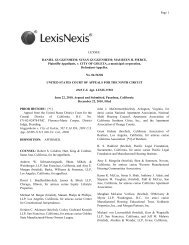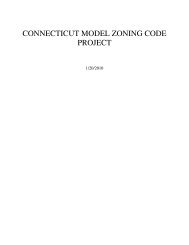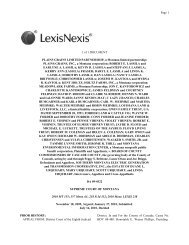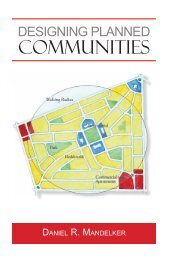Through a Glass Darkly: Measuring Loss Under ... - Land Use Law
Through a Glass Darkly: Measuring Loss Under ... - Land Use Law
Through a Glass Darkly: Measuring Loss Under ... - Land Use Law
Create successful ePaper yourself
Turn your PDF publications into a flip-book with our unique Google optimized e-Paper software.
MEASURING LOSS UNDER MEASURE 37 591<br />
variables necessarily included, ensures that to develop a model which<br />
is widely accepted as valid in economist circles (if at all possible) is<br />
likely to take a significant amount of time and money. To replicate<br />
such a model on a statewide basis and to utilize it in each and every<br />
Measure 37 claim would prove even more resource intensive. Thus,<br />
the prospect of using a complex economic model akin to that developed<br />
by Hascic and Wu to quantify Measure 37 claims, if at all possible,<br />
is certainly not achievable in the foreseeable future.<br />
E. Plantinga/Jaeger Method<br />
The eponymous valuation method was designed by Professors Plantinga<br />
and Jaeger as a corollary to their criticism of the exemption<br />
method. 105 In his paper, <strong>Measuring</strong> Compensation <strong>Under</strong> Measure 37:<br />
An Economist’s Perspective, Plantinga explains what the term “fair<br />
market value” means. 106 He concurs with the definition found in the<br />
case law—that there must be some notion of a competitive market—but<br />
asks the question: “[W]hat does the price of property represent assuming<br />
it derives from a competitive market” His answer, in short, is that:<br />
Contemporary/Current price = Annual income ÷ Interest Rate (called<br />
“the Contemporary Price Formula”) 107<br />
The Contemporary Price Formula enables the establishment of a fair<br />
market value for the property: both the current price, and, so long as the<br />
relevant annual income and interest rates are available, an accurate valuation<br />
of the property at any point in the past, the so-called Historical<br />
Fair Market Value (“Historical FMV”).<br />
The Contemporary Price Formula, in turn, informs Plantinga and<br />
Jaeger’s valuation method for Measure 37 claims:<br />
105. Although commonly referred to as the Plantinga/Jaeger method, there is no<br />
paper where Jaeger explicitly promotes this method of valuation.<br />
106. Andrew J. Plantinga, <strong>Measuring</strong> Compensation <strong>Under</strong> Measure 37: An Economist’s<br />
Perspective (Dec. 9, 2004) (unpublished manuscript, on file with Oregon State<br />
University), available at http://arec.oregonstate.edu/ faculty2/measure37.pdf.<br />
107. Id. Plantinga explains that a buyer should be indifferent between buying of land<br />
for $y, and gaining an income stream of $x; and giving up $y—by investing it in the<br />
bank, and gaining an income of $x. Moreover, in a competitive market the buyer would<br />
not buy the property at more than $y because by investing his capital ($y) in the bank<br />
(and assuming the rate of interest remained the same) the buyer would generate an<br />
income of more than $x. Conversely, a competitive market will push the price up to $y,<br />
because by investing less than $y in the bank, the buyer will generate an income of less<br />
than $x. Plantinga adds the proviso that the formula would be more complicated if the<br />
income stream is expected to fluctuate. Id. at 4.<br />
ABA-TUL-07-0701-Sullivan.indd 591<br />
9/18/07 10:43:42 AM







